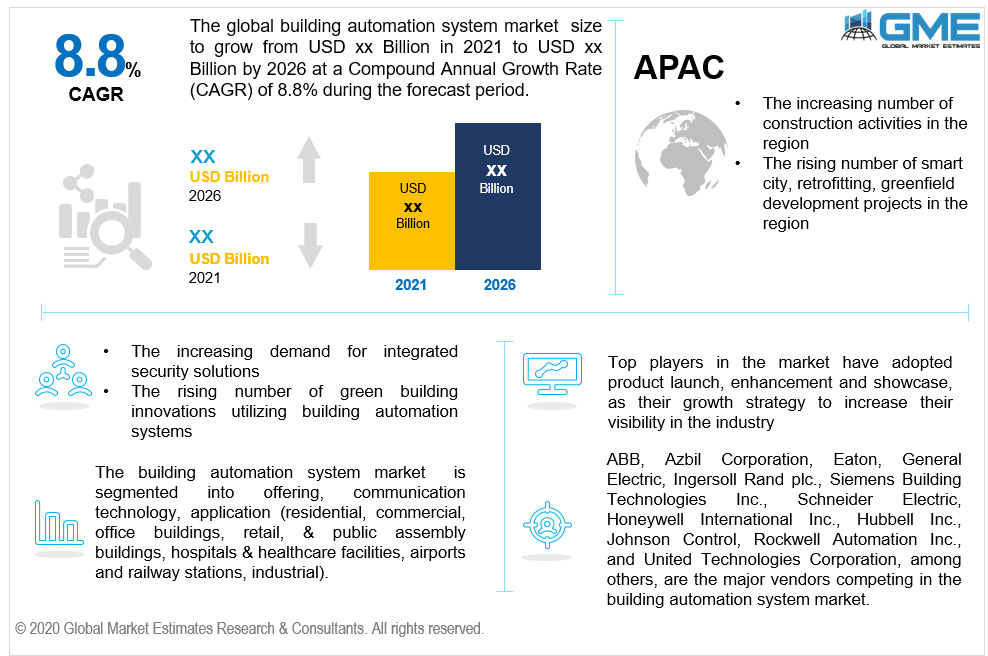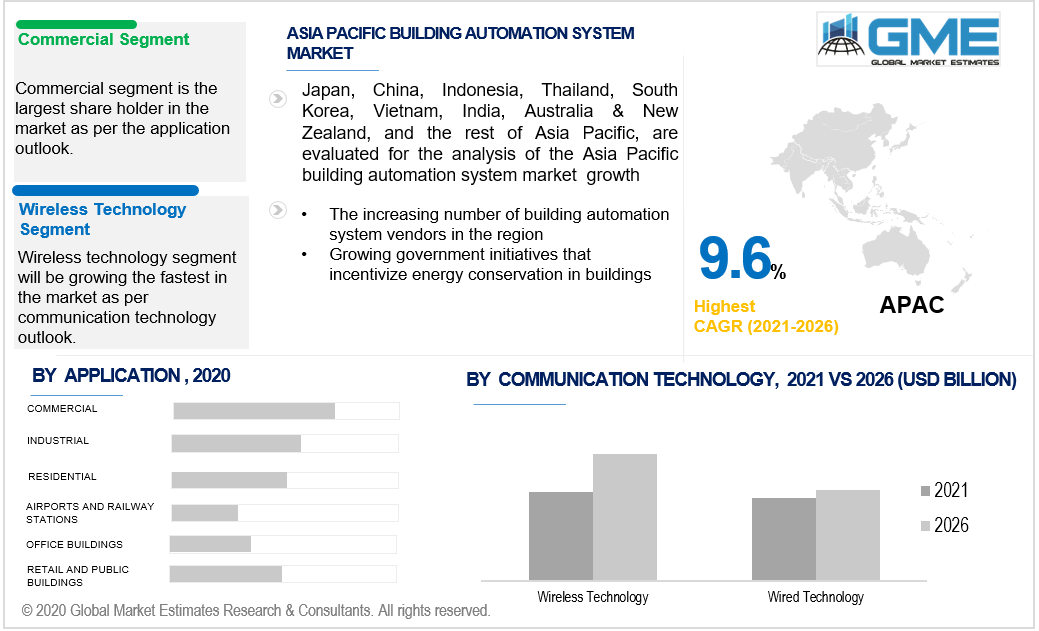
Global Building Automation System Market Size, Trends, and Analysis - Forecasts To 2026 By Offering (Facility Management Systems, Security and Access Controls, Fire Protection Systems, Building Energy Management Software, Building Automation System Services, Others), By Communication Technology (Wired Technology, Wireless Technology), By Application (Residential, Commercial, Office Buildings, Retail, and Public Assembly Buildings, Hospitals and Healthcare Facilities, Airports and Railway Stations, Industrial), By Region (North America, Asia Pacific, CSA, Europe, and the Middle East and Africa), End-User Landscape, Company Market Share Analysis & Competitor Analysis
Building automation systems consist of software and hardware that are used to monitor and control mechanical operations like lighting and ventilation. They work on a single centralized network with various software that carries out various operations like monitoring and controlling the building’s energy demand, security systems, control heating, and cooling systems. The building automation systems consist of interconnected hardware and software within a centralized network and can be used in commercial, residential, and institutional buildings. The building automation systems market is driven by the increasing need to reduce energy consumption, the growing demand for integrated security solutions, growing usage of renewable energy sources, government regulations that incentivize building automation systems that can improve energy conservation, and the growing adoption of the Internet of Things (IoT) and cloud computing. Commercial and residential buildings are the major consumers of energy in any city, they also represent a large amount of energy wastage. With the help of building automation systems, building owners can reduce the energy wastage occurring within the buildings through the use of automation systems to turn off lights and ventilation systems for a particular area based on the readings from sensors. They provide the user with a large degree of control over the various interconnected operations occurring within the building. With the advent of cloud computing, IoT, and artificial intelligence, users can completely automate the monitoring process while also accessing the network from remote locations. The growing security concerns and the rising demand for integrating security solutions are expected to increase the demand for building automation systems in the market during the forecast period. Governments across the world are introducing policies that incentivize building automation systems that can provide energy savings, with various concepts like net-zero energy buildings, green buildings, and other innovations that are all heavily dependent on intelligent building automation systems. Governments are also implementing smart city initiatives and retrofitting and greenfield development projects that emphasize the need for smart solutions and thereby the need for advanced building automation systems. The market is restrained by the growing misconceptions on the cost of building automation systems, the lack of a skilled labor force, and the complications involving the integration of various operations. The cost of implementing building automation systems is dependent on the complexity of the interoperability of the various operations, building owners fail to understand the long-term savings and benefits that can be reaped from implementing building automation systems. The growing demand for building automation systems in Hotels and the hospitality sector are promising avenues of growth for the building automation system market.

Based on offering, the building automation system market can be segmented into facility management systems, security and access controls, fire protection systems, building energy management software, building automation system services, and others. The security and access controls segment will be holding a dominant share from 2021-2026. The growing security concerns and security risk awareness have increased the demand for integrated security solutions using building automation systems. Building automation systems allow monitoring of people and goods entering and exiting the premises, keep a record of their movements, monitor activities in the premises, and protect the staff, the assets, and the information contained within the building.
Based on communication technology, the building automation system market can be segmented into wired technology and wireless technology. The wireless technology will be holding the lion's share in the market and alsohave the highest CAGR value during the forecast period i.e. 2021-2026. The wireless segment has seen an increase in demand with growing advancements in telecommunications technology and the implementation of smart hardware solutions. The growing implementation of cloud-based solutions for improved remote access is expected to further increase the demand for wireless building automation systems.
Based on application, the building automation market can be segmented into residential, commercial, office buildings, retail, and public assembly buildings, hospitals, and healthcare facilities, airports and railway stations, and industrial segments. The commercial segment is will be the largest segment of the market. Commercial building owners have access to larger capital and can absorb the high cost of implementation of building automation systems. The industrial segment will grow faster than other segments. The industrial segment includes factories, distribution plants, warehouses, and other industrial facilities crucial to the production and distribution process. Building automation systems that can save costs on energy, improve security and surveillance systems, and enhance the productivity of the buildings.

The North American region will be at the top position in the building automation market among all regions. The region has a large number of commercial buildings that are looking to implement energy conservation innovations to their buildings to reduce their carbon footprint. The APAC region will grow at the fastest growth rate during the forecast period. The APAC region is expected to see an increase in construction activities, increased demand for smart city solutions, and an increasing number of retrofitting and greenfield development projects.
Honeywell International Inc., Azbil Corporation, ABB, Eaton, Ingersoll Rand Plc., Johnson Control, Siemens Building Technologies Inc., General Electric, Schneider Electric, Hubbell Inc., Rockwell Automation Inc., and United Technologies Corporation, among others, are the majorvendors competing in the building automation system market.
Please note: This is not an exhaustive list of companies profiled in the report.
In 2021, Rockwell Aurtomation Inc. completed the acquisition of Fiix Inc., which is an AI-enabled cloud software company that specializes in computerized maintenance management systems.
In 2021, Honeywell International signed an agreement to acquire the majority stake in Fiplex Communications. Fiplex develops building communication systems and is expected to improve Honeywell’s public safety wireless communications portfolio for buildings.
We value your investment and offer free customization with every report to fulfil your exact research needs.
The Global Building Automation System Market has been studied from the year 2019 till 2026. However, the CAGR provided in the report is from the year 2021 to 2026. The research methodology involved three stages: Desk research, Primary research, and Analysis & Output from the entire research process.

The desk research involved a robust background study which meant referring to paid and unpaid databases to understand the market dynamics; mapping contracts from press releases; identifying the key players in the market, studying their product portfolio, competition level, annual reports/SEC filings & investor presentations; and learning the demand and supply-side analysis for the Building Automation System Market

The primary research activity included telephonic conversations with more than 50 tier 1 industry consultants, distributors, and end-use product manufacturers.

Finally, based on the above thorough research process, an in-depth analysis was carried out considering the following aspects: market attractiveness, current & future market trends, market share analysis, SWOT analysis of the company and customer analytics.

Tailor made solutions just for you
80% of our clients seek made-to-order reports. How do you want us to tailor yours?
OUR CLIENTS